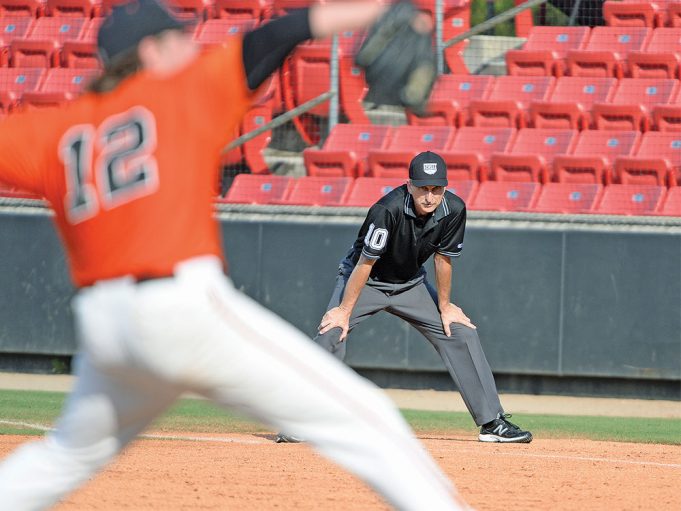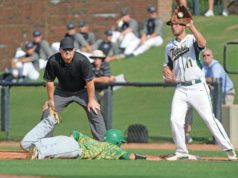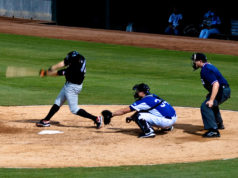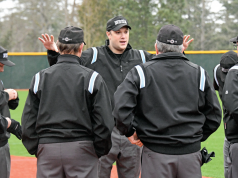Over the years, I found that the best way to stay focused and lessen the chance of a screw-up is to go through a mental checklist before each pitch. This is especially true if we’re working the bases for it can be easy to daydream, especially if the game is dragging or the score becomes lopsided. Indeed, most of us get in trouble on the bases, not the plate.
I’ve put together the following checklist. Some items will self-identify as applying when we’re working the bases or the plate, while others are applicable in both instances.
Where are the baserunners?
Sound elementary? Sure. But in my early years I cost a team a game because I thought the bases were loaded when they weren’t and called a runner out on a force at the plate when the catcher stretched for a throw with his foot on home and fell over the runner but never tagged him. At times I’ve heard other umpires say, for example, they thought there were two runners on base because they forgot that one got picked off. So although we’ll know who is where 98 percent of the time, we can’t afford to get lax and must verify this before each pitch.
Who are the runners and batter?
If you’re familiar with the teams, you may know who’s speedy and likely to try to steal or create a whacker at first on a routine ground ball to the infield, who may try to go from first to third on a hit to the outfield, who might try to stretch a single into a double, who is usually an opposite-field hitter, etc. This can help you anticipate what might happen when a pitch is thrown or the ball is hit. (Not all anticipation is bad, although we always have to expect the unexpected.) Knowing someone is a power hitter also plants the seed that it may be necessary to go to the outfield on a trouble ball.
Even if you don’t know the players, it’s easy to know whether one is a top-of-the-order player who’s more likely to be speedy, a fourth-hole hitter who probably has power, etc.
How many outs are there?
This largely dictates what the offense and defense will do, so, again, it will help you to anticipate what may happen. Is there an infield fly rule situation? If so, have you and your partner(s) signaled each other? Might there be a tag-up situation? A time play at the plate? Have you signaled that as well?
What’s the count?
Knowing the count helps you anticipate what the offense and defense might do.
Where are the outfielders?
I always glanced at the outfielders to see if they were playing a shift, were in close or deep, etc., and whether they had changed their position since the last pitch, since this could affect how a play developed. If I knew who had a good arm, it could give me an edge as plays developed.
What are my coverage duties?
I thought about how the crew needed to rotate if the ball was hit here or there in light of everything said above. And I reminded myself to peek over my shoulder if we did rotate so that I could try to “fill the hole” — cover a base left uncovered — if someone had a brain cramp.
In one College World Series years ago, there was no crew chief or prescribed mechanics and the sixth umpire, an ornery veteran, refused to go along with the mechanics the other five of us had agreed on. A play at the plate developed but he did not rotate there when the plate umpire moved to third and no one filled the hole, so they had to group-call a whacker from a long way off. Fortunately I was off and sitting in the stands in that game!
You don’t need to signal rotations with your partners before each pitch, but it’s a good idea to do it with each new batter.
Positioning.
I thought about where to go to call plays on the bases, maximizing angle over distance. At first base, for example, I’d pick a spot on the ground to go to if the ball was hit to the third baseman, shortstop, etc.
Pitchers.
With runners on base, I made a mental note to be sure the pitcher came set before delivering. It’s easy to sleep through a balk if we don’t make this part of our routine. (If that happens, let the pitching coach know between innings you screwed up so he won’t assume you think that what the pitcher did was legal.)
When I worked the plate, I tried to do everything the same way from pitch to pitch because that helped me to stay focused. I tried to ease — not jerk — into my stance at the same point of the pitcher’s delivery preparation. I thought about timing — being slow and deliberate and keeping the same rhythm in calling pitches whether they were obvious or close ones. Being slower on some calls than others can send the message that we’re unsure of ourselves.
I also stepped back away from the catcher after each pitch to reduce conversations with him or the batter and to lessen the tension that can develop if we stay in our basic stance pitch after pitch. We can’t umpire well if we’re tense. After a called third strike, I took a step or two toward the dugout opposite to the one the batter was headed to keep us from being face to face, which heightens the prospect of confrontation.
I never worked with a pitch clock, but if you do, check it as the pitcher toes the rubber and the batter steps in the box.
There are a lot of factors, including weather, lousy pitching and the like that can hurt our performance. We have a better chance of overcoming these obstacles if we become creatures of habit who develop and adhere to the same routine pitch after pitch.
What's Your Call? Leave a Comment:
Note: This article is archival in nature. Rules, interpretations, mechanics, philosophies and other information may or may not be correct for the current year.
This article is the copyright of ©Referee Enterprises, Inc., and may not be republished in whole or in part online, in print or in any capacity without expressed written permission from Referee. The article is made available for educational use by individuals.



















